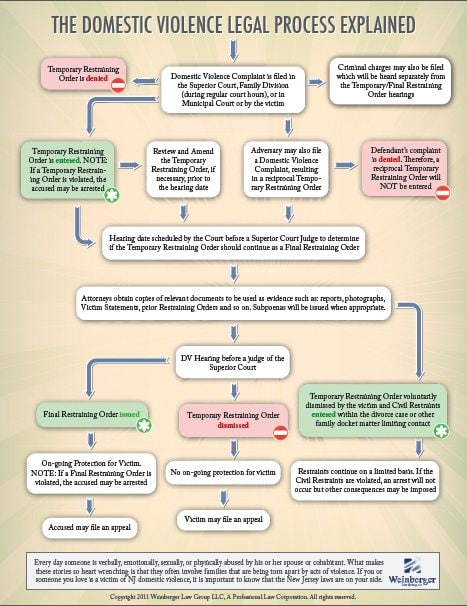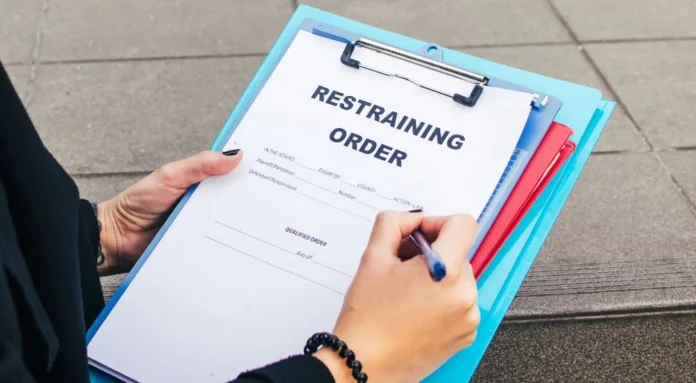To obtain a restraining order, you must provide evidence of abuse or harassment to the court. This evidence can be direct, such as eyewitness testimony of the abuse, or circumstantial, where inferences are drawn to establish facts.
In some cases, a combination of both types of evidence is presented. It is important to carefully document any incidents of abuse or harassment and gather any supporting evidence, such as text messages or emails. Seeking legal assistance can also be helpful in navigating the process of obtaining a restraining order.
Restraining orders are legal orders that prohibit someone from contacting or coming near another person. They are typically used in cases of domestic violence or harassment. If you are in a situation where you feel threatened or unsafe, obtaining a restraining order can be an important step in protecting yourself. However, it is important to understand what evidence you need to provide to the court in order to obtain a restraining order. This blog post will provide an overview of the types of evidence that may be used in a restraining order case and offer tips for documenting incidents of abuse or harassment.
Introduction To Restraining Orders
To obtain a restraining order, you need to provide evidence of abuse or harassment, such as eyewitness testimony or circumstantial evidence. In some states, like North Carolina, there are specific types of restraining orders, such as domestic violence protective orders or civil no-contact orders.
It is important to seek legal assistance when your safety is at risk.
Purpose And Types
A restraining order, also known as a protective order, is a legal document issued by a court to protect individuals from harassment, abuse, or violence. The primary purpose of a restraining order is to provide a sense of security and safety to the victim. There are different types of restraining orders, each serving a specific purpose:
- Domestic Violence Restraining Order
- Harassment Restraining Order
- Civil Restraining Order
Legal Definitions
Before understanding the proof required for a restraining order, it is essential to be familiar with some legal definitions:
| Abuse: | Physical harm, injury, assault, or the infliction of fear of imminent physical harm. |
| Harassment: | Behavior that is intended to annoy, alarm, or torment another person. |
| Stalking: | Repeated and unwanted attention that causes the victim to feel fearful. |

Credit: thedoylelawoffices.com
Eligibility Criteria
To obtain a restraining order, individuals must meet certain eligibility criteria, which may vary depending on the jurisdiction. The eligibility criteria typically include the relationship to the aggressor and the types of abuse covered.
Relationship To The Aggressor
Eligibility for a restraining order often depends on the nature of the relationship with the aggressor. This may include spouses or former spouses, individuals in a dating relationship, family or household members, and individuals who have a child together. In some cases, individuals who have been subjected to stalking or harassment may also be eligible to seek a restraining order.
Types Of Abuse Covered
Restraining orders typically cover various types of abuse, including physical abuse, emotional abuse, sexual abuse, and financial abuse. It’s important to provide evidence of the specific type of abuse experienced, such as threatening behavior, intimidation, or coercive control. Providing detailed and documented evidence of the abuse is crucial in obtaining a restraining order.
Gathering Evidence
When seeking a restraining order, gathering evidence is crucial to support your case and ensure your safety. The evidence you present can significantly impact the court’s decision to grant the restraining order. It’s essential to understand the types of evidence that can strengthen your case and provide the necessary proof for the restraining order.
Direct Vs. Circumstantial Evidence
Evidence can be categorized as either direct or circumstantial. Direct evidence includes clear, firsthand accounts of the abuse or threats, such as eyewitness testimony or video recordings. On the other hand, circumstantial evidence involves drawing inferences to establish facts based on indirect indicators, such as the presence of physical injuries or patterns of harassing behavior.
Documenting Abuse Or Threats
Documenting instances of abuse or threats is crucial in building a strong case for a restraining order. This can involve keeping a detailed record of specific incidents, including dates, times, and descriptions of the abusive behavior. Additionally, preserving any threatening messages, emails, or voicemails can serve as compelling evidence to support your petition for a restraining order.

Credit: www.findlaw.com
Witness Testimonies
In order to obtain a restraining order, you need proof of abuse or harassment. This proof can come in the form of direct evidence, such as eyewitness testimony, or circumstantial evidence, where inferences are drawn to establish facts. It’s important to gather as much evidence as possible to support your case.
Eyewitness Accounts
When seeking a restraining order, eyewitness accounts play a crucial role in substantiating the claims of abuse or harassment. Eyewitness testimony of the abusive behavior or the threatening actions can provide the court with direct evidence of the situation. These testimonies can come from individuals who have witnessed the abusive behavior firsthand and can corroborate the victim’s experience, strengthening the case for the restraining order.
Expert Witnesses
Expert witnesses can also provide valuable testimony in restraining order cases. These witnesses are individuals who possess specialized knowledge or expertise in relevant fields such as psychology, social work, or law enforcement. Their testimony can lend credibility to the victim’s claims and help the court understand the impact of the abusive behavior on the victim. Expert witnesses can offer insights into the dynamics of abuse and its potential long-term effects, further supporting the need for the restraining order.
Physical Evidence
When seeking a restraining order, physical evidence can significantly strengthen your case. It provides tangible proof of the abuse or harassment, lending credibility to your claims.
Medical Reports
Medical reports from healthcare professionals can serve as crucial evidence. They document any injuries sustained as a result of the abuse, establishing a clear link between the actions of the perpetrator and the resulting harm.
Photographs And Videos
Visual evidence in the form of photographs and videos can vividly depict the aftermath of the abuse. These images can capture injuries, property damage, or the aggressive behavior of the perpetrator, leaving little room for doubt.
Written Documentation
Police Reports
Police reports are crucial evidence for obtaining a restraining order. They document incidents of abuse or harassment, providing a formal record of the events that led to the need for a restraining order.
Communication Records
Communication records, including emails, text messages, and social media interactions, can serve as compelling evidence in support of a restraining order. These records can demonstrate a pattern of threatening or harassing behavior, strengthening the case for obtaining legal protection.
Legal Considerations
Evidence for a restraining order can include direct eyewitness accounts of abuse and circumstantial information to establish facts. In Texas cases, a mix of both types of evidence is typically presented in court proceedings.
Standard Of Proof
A restraining order is a legal tool that can have a significant impact on an individual’s life. When seeking a restraining order, it’s important to understand the standard of proof required. The standard of proof for obtaining a restraining order varies by jurisdiction, but it generally involves demonstrating a credible threat or a pattern of abusive behavior. This can be achieved through presenting evidence such as witness testimony, documentation of harassment or abuse, and other relevant information.
Impact On Legal Records
Obtaining a restraining order can have lasting implications on an individual’s legal records. Even if a case is later dismissed, the order of protection may remain on the individual’s record, potentially affecting employment opportunities and other aspects of their life. It’s crucial to consider the potential long-term impact on legal records when pursuing a restraining order, as it can have far-reaching consequences.
Filing The Restraining Order
In filing for a restraining order, evidence is crucial. This can include direct eyewitness accounts of abuse or circumstantial proof to support the case effectively. Presenting a combination of both types of evidence is common practice in Texas restraining order proceedings.
Court Procedures
Filing a restraining order involves following specific court procedures to ensure the legal process is carried out correctly. This includes submitting the necessary documentation and evidence to support your case.
Legal Assistance
Seeking legal assistance when filing a restraining order can provide valuable guidance and support throughout the process. An experienced attorney can help you navigate the legal system and ensure your rights are protected.
After The Order Is Granted
For a restraining order, you’ll need proof like eyewitness accounts or circumstantial evidence of abuse. In Texas, a combination of direct and circumstantial evidence is typically presented in court cases. This evidence is crucial in proving the need for a restraining order.
Enforcement
After the restraining order is granted, it is crucial to ensure proper enforcement to maintain safety.
Modifications And Extensions
Modifications or extensions to the restraining order may be necessary based on changing circumstances.

Credit: www.weinbergerlawgroup.com
Challenges And Appeals
When faced with challenges or denials in obtaining a restraining order, it is crucial to understand your options for recourse. Responding to denials and pursuing legal avenues for appeal can be complex but necessary steps in seeking protection.
Responding To Denials
If your request for a restraining order is denied, it’s important to review the reasons for denial provided by the court. Understanding the basis of denial can help in addressing any deficiencies in your case. Consider gathering additional evidence or clarifying existing information to strengthen your petition.
Legal Recourse
When facing a denial of a restraining order, you have the right to appeal the decision. Consulting with a legal professional experienced in handling restraining order cases can provide valuable guidance on the appeals process. Preparing a solid legal argument and presenting compelling evidence are essential in pursuing a successful appeal.
Frequently Asked Questions
Does A Restraining Order Go On Your Record In Tennessee?
Yes, a restraining order can go on your record in Tennessee, even if the case is later dismissed.
How Much Does A Restraining Order Cost In California?
The cost of a restraining order in California varies but can include filing fees and attorney fees.
What Evidence Is Needed For A Restraining Order?
To obtain a restraining order, you typically need evidence of harassment, threats, or abuse. This can include witness testimonies, police reports, text messages, or photos documenting the behavior.
How Much Does It Cost To File For A Restraining Order?
The cost of filing for a restraining order varies by state. In California, for example, the fee for a Civil Harassment Restraining Order is around $435. However, fee waivers may be available for those who qualify.
Conclusion
The evidence needed for a restraining order can include eyewitness testimonies or circumstantial proof. Combining both types of evidence is common in these cases to establish facts before the court. Seeking legal guidance can help navigate the process effectively and ensure your safety.


